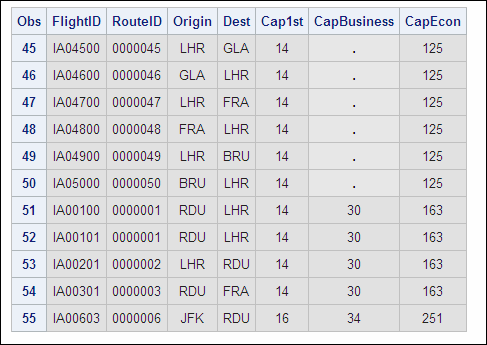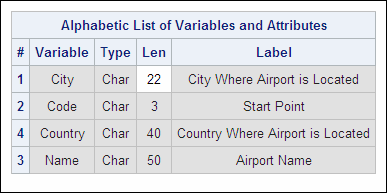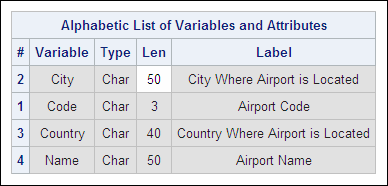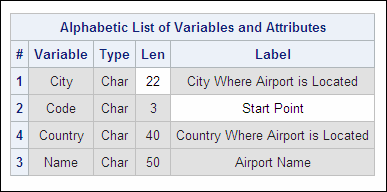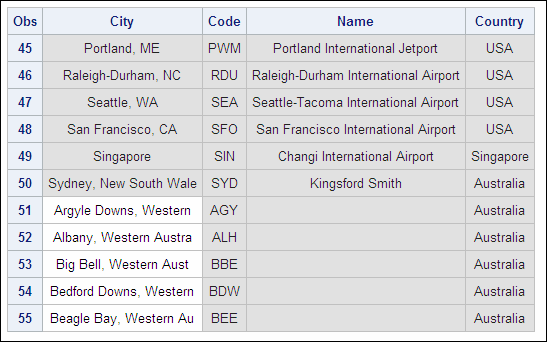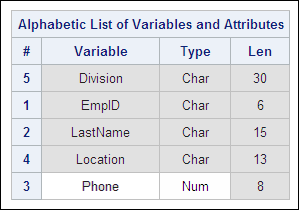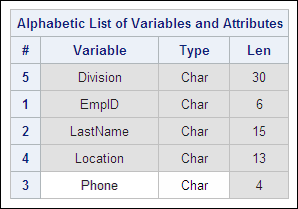Appending SAS Data Sets
Overview
Now that you have seen several methods for concatenating raw data
files, use the APPEND procedure to concatenate two SAS data sets.
|
General form, PROC APPEND:
PROC APPEND BASE=SAS-data-set DATA=SAS-data-set;
RUN;
BASE=SAS-data-set
names the data set
to which you want to add observations.
DATA=SAS-data-set
names the SAS data
set containing observations that you want to append to the end of
the BASE= data set.
|
PROC APPEND reads only
the data in the DATA= SAS data set, not the BASE= SAS data set. Therefore,
this action is very efficient. PROC APPEND concatenates data sets
even though there might be variables in the BASE= data set that do
not exist in the DATA= data set.
When the BASE= data
set contains more variables than the DATA= data set, missing values
for the additional variables are assigned to the observations that
are read in from the DATA= data set, and a warning message is written
to the SAS log.
Example
The SAS data sets Work.Cap2001
and Work.Capacity both contain the following variables: Cap1st, CapBusiness,
CapEcon, Dest, FlightID, Origin, and RouteID. However, the BASE= data
set (Work.Cap2001) contains an additional variable, Date, that is
not included in the DATA= data set (Work.Capacity).
When the following program
is submitted, the SAS log indicates that the variable
Date was
not found in the DATA= file. proc append base=work.cap2001
data=work.capacity;
run;
NOTE: Appending WORK.CAPACITY to WORK.CAP2001.
WARNING: Variable Date was not found on DATA file.
NOTE: There were 50 observations read from the data set WORK.CAPACITY.
NOTE: 50 observations added.
NOTE: The data set WORK.CAP2001 has 100 observations and 8 variables.
NOTE: PROCEDURE APPEND used (Total process time): |
The PROC PRINT output
of the appended version of Work.Cap2001 shows that missing values
have been assigned to Date in the observations that were read in from
the DATA= data set.
Note: You
can also use the DATA step SET statement to combine SAS data vertically.
If multiple data set names appear in the SET statement, the resulting
output data set is a concatenation of all the data sets listed. Unlike
the APPEND procedure, the SET statement in the DATA step reads all
observations in all input data sets in order to concatenate them.
Therefore, the APPEND procedure is more efficient than the SET statement
in the DATA step for concatenating data sets because it reads only
the data in the DATA= data set.
In the following program,
SAS reads all of the observations from Work.Cap2001, and it then reads
all of the observations from Work.Capacity.
data work.new; set work.cap2001 work.capacity; run;
Note: You can also use the SQL
procedure to combine SAS data vertically. For information about using
the SQL procedure to combine data vertically, see
Combining Tables Vertically Using PROC SQL.
Using the FORCE Option
In the previous example, the DATA= data set (Work.Capacity)
contained fewer variables than the BASE= data set (Work.Cap2001).
However, you might need to append data sets when the DATA= data set
contains more variables than the BASE= data set.
You must use the FORCE
option with the APPEND procedure to concatenate data sets when the
DATA= data set contains variables that are not in the BASE= data set.
|
General form, PROC APPEND
with the FORCE option:
PROC APPEND BASE=SAS-data-set DATA=SAS-data-set <FORCE>;
|
CAUTION:
The
FORCE option can cause loss of data due to truncation or dropping
of variables.
The structure of the
BASE= data set is used for the appended data set.
Example
Remember that the SAS
data sets Work.Cap2001 and Work.Capacity both contain the following
variables: Cap1st, CapBusiness, CapEcon, Dest, FlightID, Origin, and
RouteID. In this case, the DATA= data set (Work.Cap2001) contains
an additional variable, Date, that is not included in the BASE= data
set (Work.Capacity).
When the following program
is submitted, the SAS log indicates that the data sets were not appended
because the variable Date was not found in the BASE= file.
proc append base=work.capacity
data=work.cap2001;
run;
NOTE: Appending WORK.CAP2001 to WORK.CAPACITY. WARNING: Variable Date was not found on BASE file. ERROR: No appending done because of anomalies listed above. Use FORCE option to append these files. NOTE: 0 observations added. NOTE: The data set WORK.CAPACITY has 50 observations and 7 variables. NOTE: Statements not processed because of errors noted above. NOTE: PROCEDURE APPEND used (Total process time): real time 0.02 seconds cpu time 0.03 seconds NOTE: The SAS System stopped processing this step because of errors. |
When the FORCE option
is used with PROC APPEND, the SAS log indicates that observations
have been read from the DATA= data set, but that dropping or truncating
occurs.
proc append base=work.capacity
data=work.cap2001 force;
run;
NOTE: Appending WORK.CAP2001 to WORK.CAPACITY. WARNING: Variable Date was not found on BASE file. NOTE: FORCE is specified, so dropping/truncating will occur. NOTE: There were 50 observations read from the data set WORK.CAP2001. NOTE: 50 observations added. NOTE: The data set WORK.CAPACITY has 100 observations and 7 variables. NOTE: PROCEDURE APPEND used (Total process time): real time 0.03 seconds cpu time 0.03 seconds |
PROC PRINT output shows
that the variable
Date has been dropped from
the appended version of Work.Capacity.
Example
In the SAS data set
Work.Acities, the variable City has a length of 22. In the SAS data
set Work.WestAust, City has a length of 50. You can use the CONTENTS
procedure to view the attributes of the variables in each data set.
When the following program
is submitted, the SAS log indicates that the data sets were not appended
because of different lengths for City in the BASE= and DATA= data
sets.
proc append base=work.acities
data=work.westaust;
run;
NOTE: Appending WORK.WESTAUST to WORK.ACITIES. WARNING: Variable City has different lengths on BASE and DATA files (BASE 22 DATA 50). ERROR: No appending done because of anomalies listed above. Use FORCE option to append these files. NOTE: 0 observations added. NOTE: The data set WORK.ACITIES has 50 observations and 4 variables. NOTE: Statements not processed because of errors noted above. NOTE: PROCEDURE APPEND used (Total process time): real time 1.44 seconds cpu time 0.06 seconds NOTE: The SAS System stopped processing this step because of errors. |
When the FORCE option
is used, the SAS log indicates that the data sets are appended, but
that dropping or truncating occurs.
proc append base=work.acities
data=work.westaust force;
run;
NOTE: Appending WORK.WESTAUST to WORK.ACITIES. WARNING: Variable City has different lengths on BASE and DATA files (BASE 22 DATA 50). NOTE: FORCE is specified, so dropping/truncating will occur. NOTE: There were 50 observations read from the data set WORK.WESTAUST. NOTE: 50 observations added. NOTE: The data set WORK.ACITIES has 100 observations and 4 variables. NOTE: PROCEDURE APPEND used (Total process time): real time 1.44 seconds cpu time 0.06 seconds |
PROC CONTENTS output
for the appended version of Work.Acities shows that the variable City
has retained a length of 22 from the BASE= data set. Also notice that
the variable Code has retained the label Start Point from the BASE=
data set.
PROC PRINT output shows
that some of the values of City are truncated in the appended version
of Work.Acities.
Appending Variables with Different Types
If the DATA= data set contains a variable that does
not have the same type as the corresponding variable in the BASE=
data set, the FORCE option must be used with PROC APPEND. Using the
FORCE option enables you to append the data sets. However, missing
values are assigned to the DATA= variable values for the variable
whose type did not match.
Example
In
the SAS data set Work.Allemps, the variable Phone is a character variable.
In the SAS data set Work.Newemps, Phone is a numeric variable. You
can use PROC CONTENTS to view the attributes of the variables in each
data set.
When the following program
is submitted, the SAS log indicates that there is a type mismatch
for the variable Phone and that data sets were not appended.
proc append base=work.allemps
data=work.newemps;
run;
NOTE: Appending WORK.NEWEMPS to WORK.ALLEMPS. WARNING: Variable Phone not appended because of type mismatch. ERROR: No appending done because of anomalies listed above. Use FORCE option to append these files. NOTE: 0 observations added. NOTE: The data set WORK.ALLEMPS has 550 observations and 5 variables. NOTE: Statements not processed because of errors noted above. NOTE: PROCEDURE APPEND used (Total process time): real time 0.08 seconds cpu time 0.01 seconds NOTE: The SAS System stopped processing this step because of errors. |
When the FORCE option
is used, the SAS log indicates that the data sets are appended, but
that the variable Phone is not appended due to the type mismatch.
proc append base=work.allemps
data=work.newemps force;
run;
NOTE: Appending WORK.NEWEMPS to WORK.ALLEMPS. WARNING: Variable Phone not appended because of type mismatch. NOTE: FORCE is specified, so dropping/truncating will occur. NOTE: There were 19 observations read from the data set WORK.NEWEMPS. NOTE: 19 observations added. NOTE: The data set WORK.ALLEMPS has 569 observations and 5 variables. NOTE: PROCEDURE APPEND used (Total process time): real time 0.05 seconds cpu time 0.02 seconds |
PROC CONTENTS output
for the appended version of Work.Allemps shows that the variable Phone
has retained the type of character from the BASE= data set.
PROC PRINT output of
the appended version of Work.Allemps shows that the values for Phone
are missing in the records that were read in from the DATA= data set.
..................Content has been hidden....................
You can't read the all page of ebook, please click here login for view all page.


